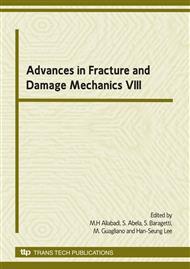p.637
p.641
p.645
p.649
p.653
p.657
p.661
p.665
p.669
An Efficient Way to Characterize the Fatigue Crack Growth Based on Numerical Analysis
Abstract:
The behavior of plasticity induced fatigue crack closure (PICC) in middle tension specimen was analyzed by the elastic-plastic finite element method. For the constant-K (CK) loading cases, the opening stress intensity factor are independent of crack length. The level of increases with the maximal applied stress intensity factor for given load ratio and increases with for fixed . The in plane strain state is much smaller than that in plane stress state. The results under CK loadings can be deduced to constant amplitude cyclic loading case during which the load ratio, maximal load level, crack length and specimen thickness are all the factors affecting the crack closure effect. The phenomena revealed in the analysis are beneficial in understanding the driving force mechanism of the fatigue crack growth.
Info:
Periodical:
Pages:
653-656
Citation:
Online since:
October 2009
Authors:
Price:
Сopyright:
© 2010 Trans Tech Publications Ltd. All Rights Reserved
Share:
Citation:


